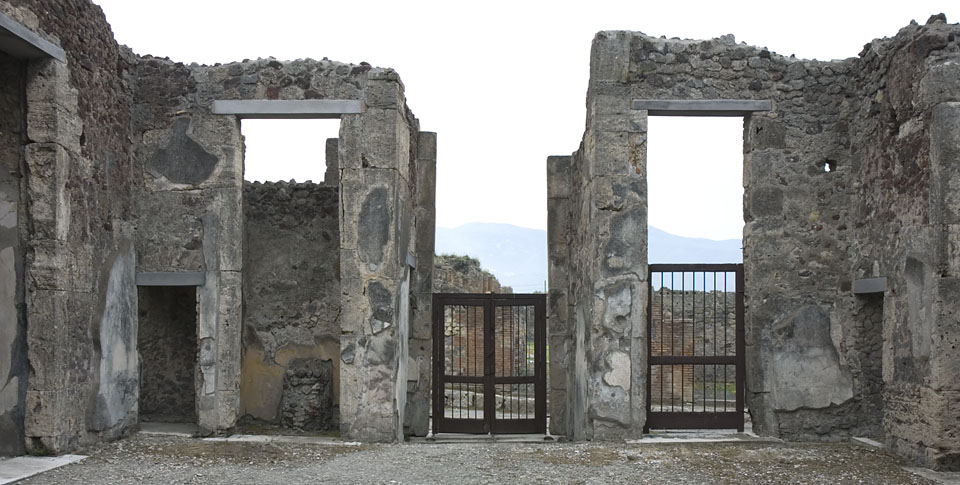South Wall
Description
Thomas Staub
South wall: width: 8.70 m
Eastern part (between eastern corner and door opening towards fauces3): width: 3.15 m, max. preserved height: 4.45 m. This part of the wall consists mainly of the door openings towards lararium5 (width: 1.31 m, height: 4.00 m) and room 6 (width: 0.70 m, height: 1.90 m) and their framings in opus a telaio in Sarno stone. The jamb between the doors towards room 6 and lararium5 is 0.45 m wide, the first block is 0.60 m high, the lower corner towards lararium5 is again cut off diagonally (height:0.15 m, width: 0.12 m). The following one has a height of 0.92 m, then 0.53 m, thereafter a stander, width: 0.45 m, height: 1.05 m, thereafter a stretcher towards the east, 1.10 m wide, 0.82 m heigh. The masonry to the east of these blocks consists in the lower parts of the area above the modern lintel of modern reconstructions and above this of a mixed opus incertum in a reddish mortar, partly covered by plaster. Above the last block lays the modern lintel over the doorway towards lararium5, and above this, further modern reconstructions. Only the eastern part of the highest zone is preserved in its original form and consists of incertum of red cruma and the reddish mortar.
In the plaster on the western doorframe towards room 6, imprints after wooden doorframes are visible (width: 0.08 m), as well as on both doorframes to lararium5 (width: 0.20 m), partly with a thin layer of plaster (0.008 m, whereas the plaster layers on the wall are 0.08 - 0.10 m thick.) The 0.65 m wide wall section between lararium5 and fauces3 consists of opus a telaio of Sarno stones, where the eastern stone in every second row engages in the east wall of fauces3. The lowest block is cut off diagonally towards the door towards lararium5 (0.05 x 0.15 m) and has a height of 1.31 m. Above this, two blocks with a height of 0.65 m, the eastern 0.30 m, the western continuing as stretcher into the east wall of fauces3, 0.35 m wide. There above follows a stander, 1.35 m heigh, above this, once more two blocks with the same measurements as before, except for the eastern one, which is 0.60 m high and on whose top the modern lintel towards lararium5 is placed. Above the lintel modern reconstructions, above the western block, a last one, 0.30 x 0.30 m large.
Opening to fauces3 width: 2.45 m, height: not preserved.
Western part (between opening towards fauces3 and west corner): width: 3.20 m, max. preserved height: 4.90 m. The section between the openings towards fauces3 and bottega V 1,6 are made of opus a telaio in Sarno stone (0.62 m wide), again with every second block reaching into the west wall of fauces3. On doorframes towards V 1,6, imprints of wooden doorframes (w: 0.21 m) van be observed. The lowest block is 1.25 m high, with, at floor level, remains of the cut off bipedales, which originally covered the lower parts of some walls. Above this stander follows two 0.68 m high blocks, the western one continuing as stretcher into the west wall of fauces3, 0.35 m wide, and the other 0.28 m. Then follows a stander, 1.30 m high, then again two blocks (0.55 m high), the western one, 0.42 m wide, continues as stretcher into the west wall of fauces3, whereas the eastern one, 0.20 m wide, recesses for approx. 0.04 m in relation to the other blocks. Plaster with ceramic sherds (0.10 x 0.10 m) filled up this space, of which some remains still are observable. Above these, a 0.62 m high block, whose upper western corner has been cut off (0.20 x 0.30 m) for the lintel to be placed here. Above the eastern part of this block, one last Sarno stone can be observed, 0.40 x 0.53 m, above the western part lays the modern lintel with modern masonry on top. In the jamb a vertical row of three round holes are visible (at 0.58, 1.22 and 3.34 m height, diam. approx. 0.05 m), which are all filled up with modern concrete.
Door opening towards V 1,6: width: 1.33 m, height: 4.05 m). On both sides, the lower corner of the doorframe is again cut off diagonally (height: 0.20 m, width: 0.10 m).
The section between the door to V 1,6 and the west corner is 1.20 m wide. The area, between a height of 0.40 m and 1.65 m, max. 0.95 m wide, is covered by plaster. On its eastern side, one can once more distinguish the edge in the plaster, against which the wooden doorframe was set. At the quoin at the western side of the door, the three Sarno stone blocks at the bottom are preserved. The lowest one is 0.28 m wide and 0.61 m high. The following block functions as stretcher with a height of 0.58 m and a width (seen on the north wall of V 1,6, since it is covered by plaster on the atrium-side) of 0.95 m. The third one is again 0.61 m high with an uncertain width, since plaster covers it on the atrium-side and modern repairs on the side of V 1,6. Above this block, the doorframe is constructed of smaller regular stone blocks (up to 0.20 x 0.30 m), both standing and lying. However, the situation here is, as on the rest of this section of the wall above the height of 1.70 - 1.80 m, unclear, due to the covering with modern mortar, and it seems plausible that this section is a complete modern reconstruction. To the west of the doorframe towards V 1,6, between floor level and the plaster, the wall consists of opus incertum with lava set into the reddish mortar. The area above the plaster, i.e. the area that might be a modern reconstruction, is built of mixed rubble and hewn stones between 0.07 x 0.07 m and 0.15 x 0.10 m large and covered by modern concrete. Along the wall, the cut off remains of bipedales are visible at floor level, not covered by the floor.

